Premium
No Eliud and Brigid, shoes a big factor in the increasingly faster times set in marathon races
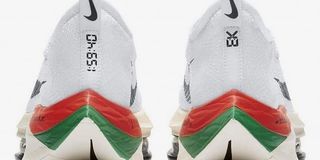
The Kenyan flag-inspired Nike “Alpha fly N% Kenya" shoes which Eliud Kipchoge used for the London Marathon on October 4, 2020.
What you need to know:
- Nike runners took 31 of the 36 podium places at the six Marathon Majors last year
- The great man himself Kipchoge has agreed that technology has been at play and should be embraced
- I see more men running sub 2 hours 3 minutes and women sub 2 hours 17 minutes, and more marathons being decided in the last 100 metres
While many people were looking at the quality line up at the 2020 London Marathon on Sunday and most in particular, hoping to be front-seat witnesses to another anticipated dominant performance by Eliud Kipchoge, my eyes were focused elsewhere.
Brigid Kosgei, the women’s world record holder, as expected won the women’s race in a time of 2 hours 18 minutes and 58 seconds while Kipchoge, the reigning Olympic Games champion and fastest human being over the distance, did not win the men’s race.
Ethiopian Shura Kitata was the shock victor in a time of 2:05:41. Kipchoge, considered the greatest marathoner of all time and only person to have run the 42km, 195 metres race in under two hours, was a distant eighth in a very slow – by his standards – 2:06:49. He talked about an ear getting blocked during the race.
This was the first time he was losing a marathon race in six years, and his first loss in 11 races.
The weather was terrible – wet and cold with and temperature below 10 degrees Celsius, but I suppose it affected all the runners.
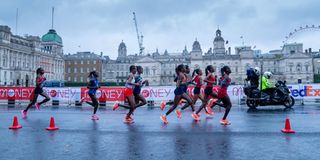
The leading pack during the London Marathon women's race on October 4, 2020.
I had expected very fast times for both men and women races, not just because of the field but the technology in place.
Most of the runners were using the latest shoe designs that are revolutionizing distance road running.
Forget about what Kipchoge and Kosgei say that the shoes really do not matter but the person running.
The five fastest times of all time on record-eligible courses have all come since September 2018 – Eliud Kipchoge (2:01:39, Berlin 2018) (2:02:37, London 2019), Kenenisa Bekele (2:01:41, Berlin 2019) Birhanu Legese (2:02:48, Berlin 2019) and Mosinet Geremew (2:02:55, London 2019)
Kosgei's also broke the great Paula Radcliffe’s 16-year old women’s record of 2:15:25 set in London 2003 when she run a blistering 2:14:04 in Chicago last year.
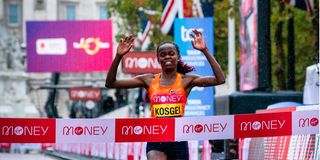
Kenya's Brigid Kosgei crosses the finish line to win the women's race of the London Marathon on October 4, 2020.
All these five athletes were using cutting edge Nike running shoes. Nike runners took 31 of the 36 podium places at the six Marathon Majors last year.
The shoes are basically the same that Kipchoge stunned the world with when he ran a sub-2 marathon in Vienna last October.
Kipchoge was in fact wearing an AlphaFly prototype boasting three carbon-fibre plates while Kosgei was in ZoomX Vaporfly Next% shoes featuring a single plate.
Amidst whispers of mechanical assistance, World Athletics stepped in to limit the thickness of the sole to 40 millimetres and one embedded plate.
World Athletics also ruled that running shoes had to be commercially available to be allowed in elite competitions.
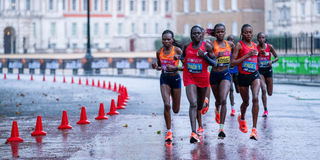
Pacesetter Vivian Kiplagat (front) in full control of the leading pack during the London Marathon women's race on October 4, 2020.
They just came short of what the International Swimming Federation (Fina) did to engineered swimsuits that were responsible for the obliteration of world records a decade ago.
The controversial Speedo LZR Racer, a radically new, full-body swimsuit made up of polyurethane, developed by swimwear manufacturer Speedo, took the 2008 Beijing Olympics swimming pool by storm.
So performance-assisting was the Speedo LZR suit favoured by many top swimmers that a whopping 25 world swimming records were broken in Beijing, more than in any previous Olympic Games.
'Technological doping'
Seeing how the suit turned wearers into human torpedoes, Speedo competitors quickly adopted and improved the technology. Swimsuit maker Arena came up with X-Glide, a superior type of polyurethane full-body suit. Within months the LZR was obsolete.
The upshot of this advancement in swimsuit technology was startling. A year later, the world records set at the Beijing Olympics were blown to kingdom come the World Swimming Championships.
The swimming world, taken aback by the ease with which world records were being shattered, started talking about ‘’technological doping”. There was also talk of how the suits – which were not cheap, were giving undue advantage to athletes from wealthy nations.
Fina in 2009 banned all full-body polyurethane suits from international competitions. That ended the frequent breaking of world records. The swimming world felt that swimmers of now were also racing against swimmers of yester-years and should do it on a level playing field – or is it pool?
The great man himself Kipchoge has agreed that technology has been at play and should be embraced.
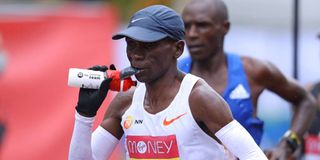
Kenya's Eliud Kipchoge refuels during the elite men's race of the 2020 London Marathon in central London on October 4, 2020.
“We live in the 21st century and we need to accept change,” he said in a media interview in England prior to the London Marathon where he ran in the controversial Nike Air Zoom Alphafly NEXT%.
In an earlier interview with Firstpost he was more forthright in his thoughts: “It is my legs that are still doing the running...With running, the effect of technology will always be minimal.” I don’t think so.
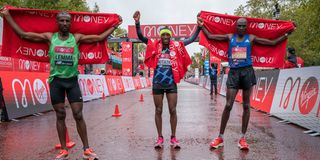
From left: Ethiopia's Sisay Lemma (third), Shura Kitata (winner) and Kenya's Vincent Kipchumba (second) pose for a photo at St James Park, London after the men's race of the London Marathon on October 4, 2020.
The outstanding Kosgei, who won the London Marathon wearing Nike Air Zoom Alphafly NEXT%, quipped: "The shoes cannot run - it's the person who runs."
However, the fact is, the stunning fast times we have seen over the last two years can be arguably attributed to the shoes.
I bet you, if athletics legends Haile Gebrselassie or Paul Tergat, previous owners of marathon world records, were to have run then in the new shoes available now, they would certainly have posted faster times.
The world is changing and I am glad World Athletics, rather than ban these type of shoes the way Fina did away with the all-body suit, has decided to allow them in competition but under regulations. Let all athletes have similar shoes.
I see more men running sub 2 hours 3 minutes and women sub 2 hours 17 minutes, and more marathons being decided in the last 100 metres. This is exciting. Thank you technology!





